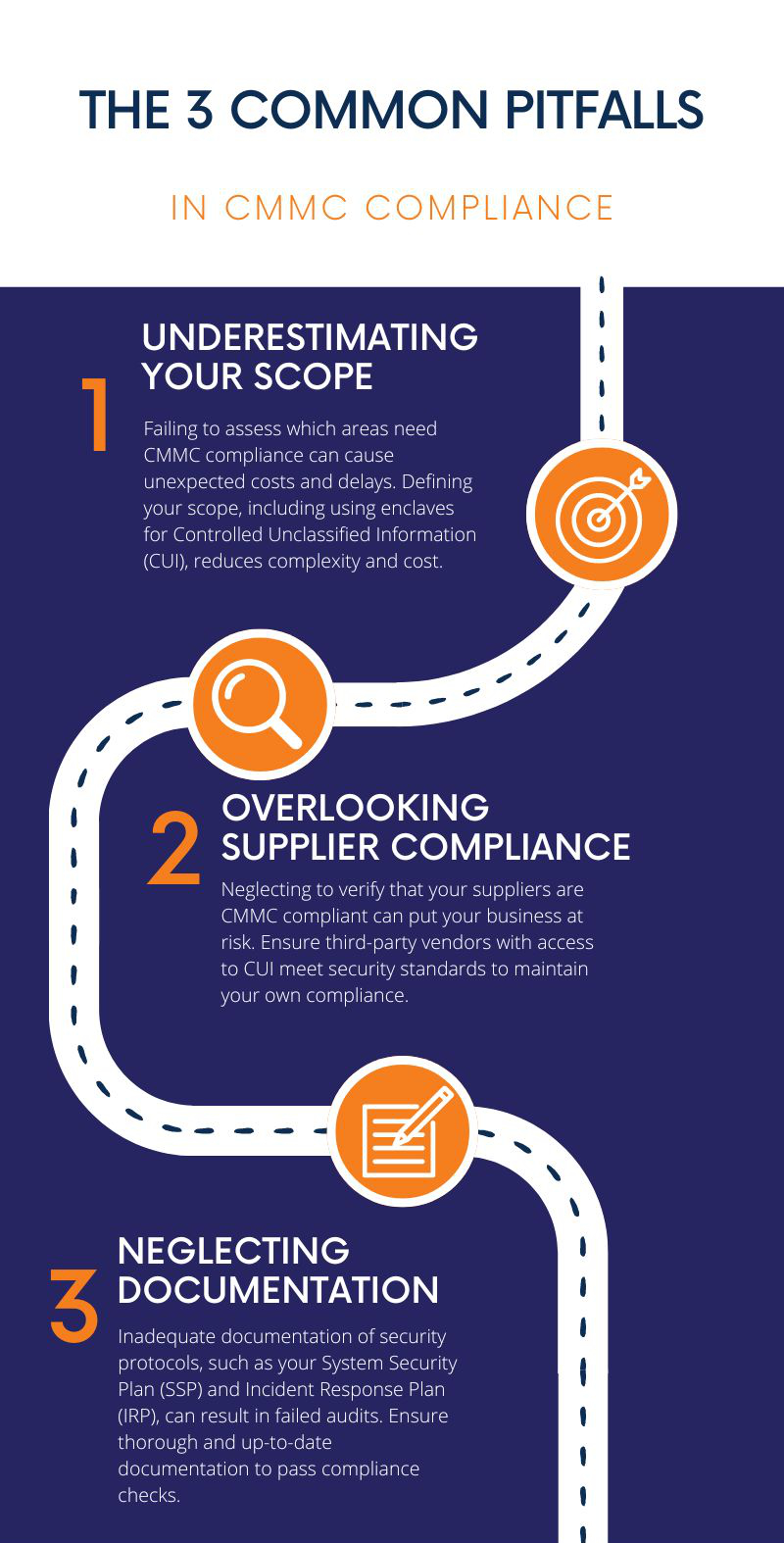As the rollout of the Cybersecurity Maturity Model Certification (CMMC) approaches, government contractors and subcontractors are facing significant challenges in preparing their systems for compliance. Achieving this is essential if you want to secure contracts with the Department of Defense (DoD), but the requirements’ complexity can lead to costly compliance errors that delay or derail your efforts. In this blog, we’ll highlight three of the most common CMMC mistakes contractors make and provide actionable tips to help you steer clear of them.
The Growing Pressure of CMMC Compliance
For contractors and subcontractors within the Defense Industrial Base (DIB), CMMC isn’t just a set of guidelines—it’s a prerequisite for doing business with the DoD. While the final stages of the CMMC rollout are still in progress (we covered the full timeline in this blog), many organizations are already knee-deep in their preparations; others are just starting.
No matter where you are in the process, one thing is certain: CMMC is complex, and getting it right is essential if you don’t want to miss out on valuable contracts. That being said, it’s also easy to stumble into some of the most common compliance mistakes, which can slow down your progress or result in failed audits. Let’s dive into the top three pitfalls to avoid as you work toward achieving CMMC compliance.
Mistake #1: Underestimating Your Scope
One of the most frequent CMMC mistakes contractors make is underestimating the scope of what CMMC compliance requires. This can lead to unexpected costs, delays, and confusion, particularly if you don’t fully understand which parts of your business need to be compliant and how deep the requirements go.
The CMMC framework has different levels of security controls depending on the sensitivity of the data your business handles. However, this doesn’t necessarily mean that every single aspect of your business needs to meet the highest level of compliance. For some contractors, it’s possible to create ‘enclaves’ within the organization, segregating parts of the business that don’t handle Controlled Unclassified Information (CUI) from those that do.
How to Define Your Scope
This can significantly reduce the cost and complexity of achieving compliance—but it also requires careful planning. You need to understand where the boundaries protecting CUI lie within your organization.
Ask yourself (or work with an IT support team with CMMC compliance expertise to figure out):
- How will you define these enclaves, if applicable?
- Will any of your current processes need to change to ensure CUI is properly protected?
- How will you ensure your employees follow any new procedures related to these enclaves?
Another key part of this is accounting for the ongoing nature of compliance. CMMC isn’t a “set it and forget it” process—it requires regular monitoring and maintenance. Your business will need to continuously assess compliance, perform security checks, and ensure employees adhere to updated security protocols.
Underestimating the time, cost, and effort required for this ongoing process is one of the most important compliance errors to avoid.
Mistake #2: Overlooking CMMC Compliance in Your Suppliers
Another critical compliance error contractors often make is overlooking security in their external suppliers. If you’re working with third-party vendors or subcontractors and they have access to CUI, they need to be CMMC compliant as well.
This requirement extends beyond your internal security measures and applies to the entire supply chain. Ensuring that your partners and vendors are meeting the necessary CMMC standards is a key part of maintaining your own compliance.
How to Verify Supplier CMMC Status
Failing to verify the compliance status of your suppliers is one of the most overlooked yet common compliance mistakes for contractors. To avoid this, you need a robust process for vetting and verifying your suppliers. Here are some steps you can take:
- Ask for evidence of your suppliers’ CMMC compliance.
- Verify that their systems, tools, and protocols meet the necessary security standards.
- Review any contractual agreements to ensure that compliance is addressed.
What Happens If One of My Suppliers Isn’t CMMC Compliant?
If a vendor or subcontractor with access to your CUI doesn’t meet CMMC requirements, your business could fail an audit or be at risk of a breach, which could result in lost contracts or costly penalties.
If you discover that one of your suppliers isn’t compliant, consider taking immediate steps to secure your CUI by either:
- Limiting their access, or
- Switching to a vendor who is CMMC certified.
Mistake #3: Neglecting Proper Documentation
Neglecting proper documentation is a common and easily avoidable compliance error that can severely hinder your efforts to achieve CMMC certification. Documenting your cybersecurity policies, procedures, and incident response plans is not only necessary for internal clarity—it’s a critical requirement for passing an audit. Without thorough documentation, even the best security controls won’t be enough to prove your compliance to an auditor.
How to Achieve Thorough Documentation
Leaving documentation to the last minute almost guarantees more headaches than necessary. It’s important to approach this task proactively and ensure that your documentation is comprehensive and well-organized.
Three key documents to prioritize are your:
- System Security Plan (SSP): This outlines how your business protects CUI and implements required controls.
- Incident Response Plan (IRP): This provides a clear process for responding to cybersecurity incidents, such as data breaches or attacks.
- Policy and Procedure Documentation: This formalizes your day-to-day security practices and ensures your employees understand their roles in maintaining compliance.
In addition to these core documents, auditors will look for evidence that you’re following your written policies. For example, simply stating that you have an incident response plan isn’t enough—you need to provide evidence that it’s been tested and employees know how to implement it. Without proof, you run the risk of failing your audit, even if you have the right policies in place.
Neglecting documentation is a classic CMMC mistake that can be avoided by planning ahead. Take the time to document your policies early on, and make sure your system security and incident response plans are thorough and regularly updated. Additionally, ensure that you have evidence of implementation, so when auditors come knocking, you have everything ready to go.
Seek Help from An Experienced, CMMC-Certified IT Support Provider
An experienced IT support provider with a strong background in compliance can be a valuable partner for government contractors working toward CMMC certification. They can help with:
- Comprehensive Compliance Assessments: Conducting thorough reviews of your current security controls, identifying gaps, and providing solutions aligned with CMMC requirements.
- Enclave Creation for CUI: Assisting in setting up secure silos within your organization to limit the scope of compliance, reducing cost and complexity by ensuring only necessary parts of your business handle Controlled Unclassified Information (CUI).
- Ongoing Monitoring and Audits: Implementing regular compliance monitoring and performing internal audits to ensure continuous adherence to CMMC standards, rather than focusing on just one-time certification efforts.
- Documentation Management: Handling the creation, organization, and management of critical documentation, such as your system security plan (SSP) and incident response plan (IRP), while also ensuring evidence of compliance is readily available for auditors.
By leveraging the expertise of a compliance-focused IT support provider, you can avoid the most common compliance errors and streamline your path to certification. And, by partnering with a team who are themselves CMMC-certified, you’ll know you’re receiving guidance from professionals who understand the challenges you’re facing.
Avoid These Common CMMC Pitfalls to Secure Future DoD Contracts
CMMC compliance is by no means a simple task, but by avoiding these common compliance mistakes for contractors, you can ensure that your business is prepared for certification.
Don’t underestimate the scope of your compliance efforts—plan your strategy carefully and avoid surprise costs or delays. Make sure your suppliers are compliant, too, as their lack of security can put your own contracts at risk. And finally, don’t wait until the last minute to tackle documentation—proper, thorough records are essential for passing your audit.
By staying aware of these common CMMC mistakes and taking proactive steps to rectify them, you can position your business for success in securing future DoD contracts. The cost of compliance errors is too high to ignore, so ensure that you’re following best practices to keep your systems secure and your company on track.
Infinity Technologies: North Virginia’s Premier Managed IT, Cybersecurity, and IT Support Partners
At Infinity Technologies, we specialize in providing IT and cybersecurity solutions that cover all bases—from support and ongoing assessments to threat management, response, and recovery—to SMBs in Charlottesville, VA, and beyond.
Our services are designed to keep your business safe, secure, and operational, no matter the challenges you face.
Curious to see the difference we can make for your SMB? Contact us today to learn how our IT support and cybersecurity solutions can provide the robust protection your business deserves.




